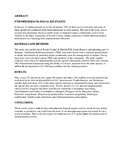Antiplasmodial potential of traditional antimalarial phytotherapy remedies used by the Kwale community of the Kenyan Coast.

View/
Date
2015-05-20Author
Muthaura, CN
Keriko, JM
Mutai, C
Yenesew, A
Gathirwa, JW
Irungu, BN
Nyangacha, R
Mungai, GM
Derese, S
Language
enMetadata
Show full item recordAbstract
ETHNOPHARMACOLOGICAL RELEVANCE:
In Kenya, 22 million people are at risk of malaria, 70% of them are in rural areas and most of these people use traditional plant based medicines to treat malaria. The aim of the study was to escalate documentation, from an earlier study of medicinal plants, traditionally used to treat malaria by the Digo community of Kwale County, taking cognizance of their pharmacological information by evaluating their antiplasmodial efficacies.
MATERIALS AND METHODS:
The study was carried out in Kwale County at Shimba Hills Game Reserve and adjoining part of Kinango. Traditional health practitioners (THP) were interviewed with a standard questionnaire to obtain information on medicinal plants traditionally used for management of malaria. Group interviews were also held among THPs and members of the community. The plant samples collected were tested for antiplasmodial activity against chloroquine sensitive (D6) and resistant (W2) Plasmodium falciparum using the ability of extracts, prepared from the plant species, to inhibit the incorporation of [G-3H] hypoxanthine into the malaria parasites.
RESULTS:
Fifty seven (57) species in forty eight (48) genera and thirty (30) families were documented and evaluated for in vitro antiplasmodial activity. Apocynaceae, Euphorbiaceae, and Rubiaceae families had each about 12% of the plant species reported as antimalarial remedy and represented the species that are most commonly used. Twelve species (21.1%) showed antiplasmodial efficacy of IC50<5µg/ml and these were Boscia salicifolia, Cissampelos mucronata, Clerodendrum myricoides, Commiphora schimperi, Flueggea virosa, Maytenus undata, Maytenus senegalensis, Maytenus putterlickioides, Vernonia amygdalina, Warburgia stuhlmannii, Zanthoxylum chalybeum and Tabernaemontana pachysiphon.
CONCLUSIONS:
These results seem to indicate that ethnopharmacological inquiry used in search for new herbal remedies as predictive and could form the basis of an ethnopharmacopoeia and search for new active principles. This is the first report on traditional use of T. pachysiphon for malaria and its antiplasmodial activity
Citation
J Ethnopharmacol. 2015 May 20. pii: S0378-8741(15)00356-6Publisher
University of Nairobi
